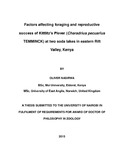| dc.description.abstract | Ground nesting shorebirds are perennially at risk from an array of threats arising
from activities of humans, other animals and climate induced factors. People and
wild animals can destroy nests and kill young birds as well as cause direct and
indirect disturbance on shorebirds. Climate variability influences the hydrological
cycle thereby causing changes in lake water levels and the extent of the
shorelines in aquatic ecosystems. Lakes Nakuru and Elmenteita situated in
Kenya’s Rift Valley are internationally important for the conservation of
shorebirds and are facing the pressures of increase human activity and climate
variability. This study investigates how these factors influence the foraging and
breeding success of Kittlitz’s Plover (Charadrius pecuarius TEMMINCK) at these
two lakes. Specific objectives were to determine the population size, potential
food and foraging behaviour as well as assess the breeding performance of the
Kittlitz’s Plover.
The study established that Lake Nakuru and Lake Elmenteita support a
maximum of 544 and 124 birds respectively giving a total estimate of 668 birds.
The two sites combined give a long term mean (±SD) population of 285.3 ± 162.6
birds, which is approximately 0.29% of the world population of the species. An
assessment of invertebrates, as potential food for the Kittlitz’s Plover using pitfall
traps, identified fourteen taxonomic families in six orders of Arthropods.
Coleoptera comprising 96% and 89% of all the invertebrates captured at Lakes
Elmenteita and Nakuru respectively were the most abundant potential prey. The
foraging rates were significantly higher in areas with low human disturbance. The
mean (±SD) Foraging Effort (i.e. number of steps made per individual in 30
seconds while foraging) at Lake Nakuru was 34.83 ± 9.74, which was
significantly higher (Mann-Whitney U = 1373.5, n = 63, P = 0.003) than that of
Lake Elmenteita (30.95 ± 9.36). The mean (±SD) Foraging Efficiency (i.e.
number of pecks made per individual in 30 seconds while foraging) was also
significantly higher at Lake Elmenteita (9.24 ± 4.11) compared to Lake Nakuru
7.24 ± 4.11 (Mann-Whitney U = 1381.5, n = 63, P = 0.003). The mean (±SD)
Food Intake rate (i.e. number of swallows made per individual in 30 seconds
while foraging) was also higher in Lake Elmenteita (4.70 ± 2.41) than Lake
Nakuru (3.70 ± 2.41) (U = 1506.5, n = 63, P = 0.019). Overall, the birds at Lake
Elmenteita experienced higher food availability, spent less energy feeding and
achieved higher foraging success rate compared to those resident in Lake
Nakuru. Nesting success of Kittlitz’s Plover was highest in medium level
disturbance areas and lowest in areas of highest human activity. The main
causes of nest failure were flooding (52%), vehicle damage (36%) and predation
(12%). Using the Mayfield nest loss estimator, Lake Elmenteita had higher
nesting success rate (43%) than Lake Nakuru (37%). The combined nest survival
rate for the two lakes was 41%, which indicates that the two sites were still good
for breeding by Kittlitz’s Plover. Results of this study revealed no significant
difference between the two lakes in the number of nests built, eggs laid and
chicks hatched. Lake Elmenteita contributed significantly more chicks (72.7%,
48/66) compared to Lake Nakuru at 27.3% (18/66). The mean (± SD) number of
tourist vehicles (21.7 ± 42.7) and people (6.3 ± 17.0) walking per kilometre of
shoreline per day, was higher at Lake Nakuru compared to Lake Elmenteita
where no tourist vehicles were recorded. The mean (± SD) number of wild
mammals, including predators, in the Kittlitz’s Plover habitats at Lake Nakuru
was estimated at 23.2 ± 58.0 per kilometre of shoreline per day. The frequency of
human, herbivore and predators’ foot prints, tyre marks and dung piles revealed
higher disturbance levels at Lake Nakuru by large mammals (64.1%), humans
(81.7%) and vehicles (92.9%) than at Lake Elmenteita where the frequencies of
those threats stood at 35.9%, 18.3% and 7.1% respectively.
The upward trend in visitor numbers, especially at Lake Nakuru and growing
settlements around Lake Elmenteita, envisage increased human disturbance
along the lake shores. The changes in climatic conditions envisage increased
occurrences of flooding and drought. The study recommends instituting
mitigation measures such as increased awareness about the breeding birds,
zoning of the shoreline for visitors and digging of trenches to curb human
disturbance and climate impacts, and conserve the nesting birds. | en_US |

